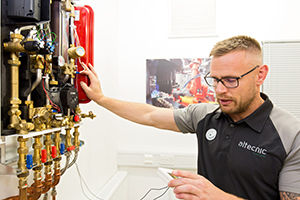Train for the future

The government is investing £320 million in district heat networks. For some, this may be a new technology so it can in many cases be misunderstood and this lack of understanding means that some potentially efficient systems are delivering under par performance figures.
In part this may be because a lack of regulation means there are actually some inefficient products or components on the market being used in such systems. Specifiers may check that products are fit for purpose, but occasionally the specification is broken further down the supply chain. To show how this can be prevented let’s take heat interface units (HIUs) as an example. One step that a specifier can take is to specify that the unit is BESA certified or to specify certain performance characteristics that the HIU must achieve (a maximum VWART figure for example).
But the bigger problem is still a lack of industry understanding surrounding the operation, use and the holistic nature of heat networks. If you get the specification wrong then you are clearly culpable, but others in the supply chain and other products on the network can adversely affect your system during installation, operation and then subsequent maintenance. Sadly, this leaves dissatisfied end users, which affects your reputation and leaves heat networks with an unjustified bad press. It is for this reason that CIBSE’s Heat Networks Code of Practice (CP1) recommends utilising a heat network specialist from the start.
Training
CIBSE conducts training on CP1 with the intention of improving the knowledge and understanding of heat networks. Manufacturers are also, or should be, well versed in the technology that they have developed and how it fits into a complete heat network. Although training is available, many of the engineers actually working on these systems are not specialists and their understanding of how HIUs work is essential in contributing to an efficient system
The first time that many heating engineers come across a heat network is when they are asked to install or maintain the components of a specified system. Despite the fact they can install from a drawing, they might not fully understand the hydronic principle behind its operation. This presents a problem when ongoing maintenance is required as faults can often be misdiagnosed due to lack of knowledge or understanding.
Fortunately, some support is available from manufacturers’ technical teams in finding the root cause of an underperforming heat network. Companies such as Altecnic have invested and trained their specialists to become CIBSE accredited Heat Network Consultants.
Heat networks are fundamentally different to traditional heating and hot water systems, which is why they are so effective in saving energy and carbon if specified and installed properly. This, however, can also cause issues because diagnosing and fixing issues are also very different.
In a heat network or district heating system an individual apartment, or even house, is just one part of the system. An apartment will receive its hot water and heating from a central supply via a heat interface unit (HIU). There is no gas supply to a HIU, it simply manages the LTHW received from the central supply and then uses the embedded energy in this supply to provide heating and generate DHW within the apartment.
In a non-centralised, traditional system when there is a fault it is often an issue with the boiler. In contrast when there is a fault in a heat network system, it is generally a fault in the supply system and not with the HIU. The installer’s or maintenance engineer’s instinct however is to begin with the HIU.
If you have ever designed a district heating system you will know how essential it is to achieve a low return temperature. By maximising differential temperature (ΔT), you can reduce required flow rates while ensuring hot water production at the outlet.
Approval

A knock-on effect of this is a massive reduction of heat network installation and operational costs, by reducing flow rates you can use smaller diameter pipework and reduce pump sizing as a result. Smaller pipework reduces network losses and the potential for building overheating.
A BESA-approved HIU will ensure that the differential temperature is kept as wide as possible. To maximise the performance benefit of an approved HIU, consideration of the tertiary circuits (apartment space heating) are required. It is critical that the approach temperature across the HIU is not reduced below acceptable limits, so the network flow temperature and the apartment flow temperature need to be carefully selected.
Teamwork
The HIU also needs to ensure that it maintains a significant approach temperature on the return to the network. The delta T on the tertiary circuits (apartment space heating) needs to be maximised to avoid compromising the performance of the HIU and therefore the network as a whole. This can be accomplished by correct flow balancing of the tertiary using pre-settable radiator valves along with maximising surface area of any heat emitters.
Having an HIU that has the facility for return temperature limitation will also ensure that the network delta T is maximised.
In conclusion, in order to achieve the potential of a district heat network, currently the only answer available is to involve the manufacturer from the beginning – they understand the technology and can also deal with everyone in the supply chain. Make sure that whoever is responsible for the installation receives appropriate training. Altecnic for example conducts its own CIBSE approved CPD training for both specifiers and installers.
Reputable companies want a district heating system to succeed.
Looking towards the future it is time that training for engineers covers all technologies available not just those most often seen. The government is rightly investing a lot of money in heat networks and the infrastructure needed to help cut our country’s carbon emissions, it is up to us as an industry to collectively improve knowledge and look towards a de-carbonised future.
Gary Perry is managing director of Altecnic







